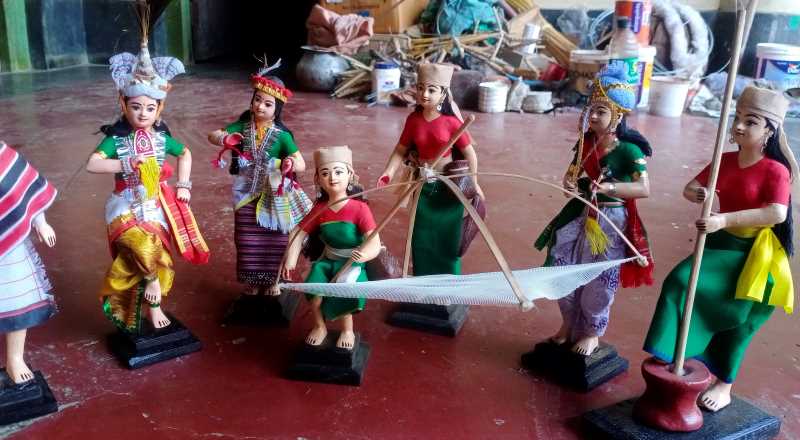Sitting in a corner of his house veranda at Kongba, Imphal East, which is his only workplace, Laiphadibi (local doll) maker Padma Shri Konsam Ibomcha dreams of opening a gallery of dolls to showcase the nearly extinct local art form of the indigenous people of Manipur practised since time immemorial.
The only thing hurdle in fulfilling his long awaited dream is the financial issue, said Ibomcha while speaking to the Imphal Free Press.
Sixty-year-old Ibomcha was conferred the Padma Shri Award for his distinguished services in Arts on Republic Day 2022.
According to Ibomcha, conferring him the Padma Shri, one of the highest civilian awards of the country, is a big surprise to him. “It might have been recommended by someone who loves my work and truly understands the value of the art of making Laiphadibi. I thanked the person with all my respect,” he said.
The conferment of Pad Shri Award on Ibomcha shows that the country has finally recognised the art of Laiphadibi making, which is dying as many has given up the local art form, Ibomcha said.
The art of Laiphadibi making is presently practiced by around only five individuals in Manipur, he said.
 (PHOTO: IFP Images)
(PHOTO: IFP Images)
“Conferring me the Padma Shri is the biggest achievement of my life. It shows that the country has recognised the arts of Laiphadibi making. I am very grateful that the country has recognised the artworks of an unsung artist like me,” he added.
The century old legacy of Laiphadibi making technique was passed on to him during his young age from his father late Konsam Tona Singh who was a national awardee. Nevertheless, his mother, late Konsam ongbi Gambhini Devi was also a national awardee for Kauna craft.
Running his family of five members, which includes his wife and three children, with only the small income received from selling Laiphadibi, Ibomcha is still unable to open a shop for dolls in his around 50 year-long career of doll making.
The traditional Laiphadibi did not have any facial features or legs, only a vertical line of colourful thread was stitched across the face to signify the features. However Ibomcha tweaked the way of traditional Laiphadabi making by innovating new materials.
He uses metal wire, straw and thread to make the skeleton of the dolls to make it flexible. For the distinct bodily features, he uses a mixture of clay and jute, old discarded cloth and traditional gum made from maida (flour) followed by painting of the body and dressing of the dolls.
His better half Konsam Ongbi Chandrima Devi helped him in making the dress for the dolls.
According to Ibomcha, a normal Laiphadibi is sold at Rs 1,000 per piece and is able to make a maximum of around 30 dolls per month. So his monthly average income is around Rs 25,000 to 30,000. But the amount is low for him to manage his source of livelihood and his family as well.
“The demand for Laiphadibi is very high, it is mostly used as a souvenir item mostly by those Manipuri staying outside the state. However due to lack of manpower I am unable to meet the demands,” said Ibomcha.
As his doll production rate is very low, he attended only a few exhibitions in his life, he added.
Ibomcha also expressed the need of passing the endangered art form of Laiphadibi making to the future generation to preserve traditions, as only around five Laiphadibi makers exist in Manipur currentlythe art.
He also expressed dissatisfaction for not including a course on Laiphadibi making in the state government’s Doll Toy Making and Training Centre located at Porompat, Imphal East.
“In order to preserve it, there is a need of establishing a training centre without having any time bound for the course,” said Ibomcha explaining that until a person is able to make perfect production of the doll, the training is meaningless.
Being a kind hearted man, Ibomcha, regardless of his low income, has been giving free Laiphadibi making tutorials to many students by even supplying them with the raw materials available in his home.
Ibomcha lastly drew the attention of the government for establishing a training centre for such endangered art forms of the diverse communities of Manipur and for providing a common workspace for those artists as many artists like him and students do not have a proper workplace.